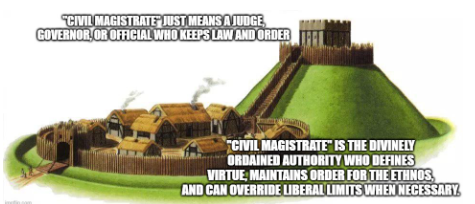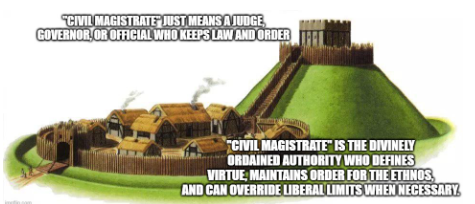Woke Right "Civil Magistrate"
Do not be deceived by the Woke Right use of "civil magistrate", it is a polysemantic term that carries a mundane or layman meaning and an initiate esoteric meaning.
This allows the Woke Right to use this term in a Motte and Bailey smuggling operation.
Polysemy: Civil Magistrate
Everyday sense (layman):
“Civil magistrate” just means a judge, governor, or government official who keeps law and order.
Sounds harmless, traditional, almost quaint.
Post-Liberal sense (initiate):
“Civil magistrate” is the divinely ordained authority who defines virtue, maintains order for the ethnos, and can override liberal limits when necessary.
This is not just “administration” — it’s moral rule.
Do not be deceived by the Woke Right use of "civil magistrate", it is a polysemantic term that carries a mundane or layman meaning and an initiate esoteric meaning.
This allows the Woke Right to use this term in a Motte and Bailey smuggling operation.
Polysemy: Civil Magistrate
Everyday sense (layman):
“Civil magistrate” just means a judge, governor, or government official who keeps law and order.
Sounds harmless, traditional, almost quaint.
Post-Liberal sense (initiate):
“Civil magistrate” is the divinely ordained authority who defines virtue, maintains order for the ethnos, and can override liberal limits when necessary.
This is not just “administration” — it’s moral rule.

Woke Right Civil Magistrate Motte and Bailey
In Post-Liberal discourse, the phrase “civil magistrate” is not neutral, it carries layered meaning depending on whether you’re looking at the surface (motte) or the deeper (bailey/initiate) level.
Layman / surface sense (motte)
A “civil magistrate” is presented as simply a public official — judges, legislators, executives, local rulers.
It sounds like a benign, almost biblical or old-world way of saying “government authority.”
To a casual reader, it comes across as continuity with the Founding-era language (e.g. colonial sermons often spoke of magistrates as God’s servants of justice).
Post-Liberal / initiate sense (bailey)
For Post-Liberals, the “civil magistrate” is not just a neutral officeholder. It is the agent of moral ordering — the person (or class) empowered to enforce virtue, define the good, and discipline society.
Unlike Classic American Liberalism, which sees magistrates as bound by transcendent law and limited by rights, Post-Liberalism sees them as instruments of decision: they have authority to determine what is virtuous for the people and to wield coercive power accordingly.
In Schmittian or decisionist terms, the magistrate is the one who can “decide the exception” — i.e. declare what circumstances require suspending ordinary limits to reassert order.
Why this matters
For Classic American Liberalism: The magistrate is a servant bound by natural law and the Constitution.
For Post-Liberalism: The magistrate is a moral ruler, custodian of ethnos, empowered to impose order even against liberal limitations.
So when a Post-Liberal invokes the “civil magistrate,” they’re not just talking about officials carrying out laws, they’re gesturing toward a theologically and historically-justified authority figure who governs not just by law, but by claimed moral mandate.
In Post-Liberal discourse, the phrase “civil magistrate” is not neutral, it carries layered meaning depending on whether you’re looking at the surface (motte) or the deeper (bailey/initiate) level.
Layman / surface sense (motte)
A “civil magistrate” is presented as simply a public official — judges, legislators, executives, local rulers.
It sounds like a benign, almost biblical or old-world way of saying “government authority.”
To a casual reader, it comes across as continuity with the Founding-era language (e.g. colonial sermons often spoke of magistrates as God’s servants of justice).
Post-Liberal / initiate sense (bailey)
For Post-Liberals, the “civil magistrate” is not just a neutral officeholder. It is the agent of moral ordering — the person (or class) empowered to enforce virtue, define the good, and discipline society.
Unlike Classic American Liberalism, which sees magistrates as bound by transcendent law and limited by rights, Post-Liberalism sees them as instruments of decision: they have authority to determine what is virtuous for the people and to wield coercive power accordingly.
In Schmittian or decisionist terms, the magistrate is the one who can “decide the exception” — i.e. declare what circumstances require suspending ordinary limits to reassert order.
Why this matters
For Classic American Liberalism: The magistrate is a servant bound by natural law and the Constitution.
For Post-Liberalism: The magistrate is a moral ruler, custodian of ethnos, empowered to impose order even against liberal limitations.
So when a Post-Liberal invokes the “civil magistrate,” they’re not just talking about officials carrying out laws, they’re gesturing toward a theologically and historically-justified authority figure who governs not just by law, but by claimed moral mandate.

• • •
Missing some Tweet in this thread? You can try to
force a refresh











